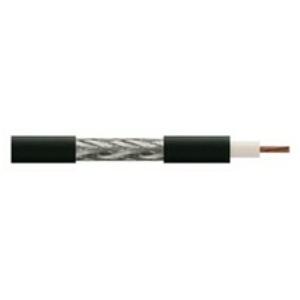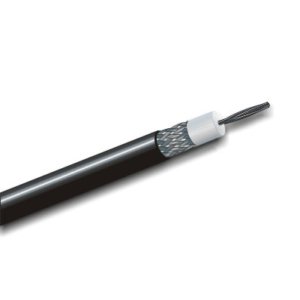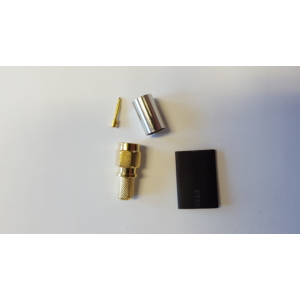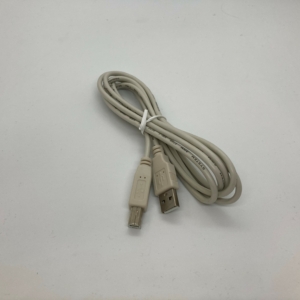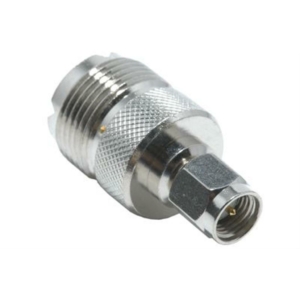Description
The SDRPlay RSP1B is an enhanced version of the SDRPlay RSP1A the popular lowest cost receiver—it is a powerful wideband full featured 14 bit SDR and perfect as an all round general coverage communications receiver plus much much more.
The key advantages over the RSP1A are that it comes in strong black painted steel case instead of plastic, and (compared to the RSP1A) has significantly improved noise performance below 1MHz (i.e for LF and below), and in the 50-60 MHz region. There are also noticeable noise improvements in the 3.5-5.5MHz and 250-320MHz spectrum. It also has it has improved signal handling at HF frequencies compared to the RSP1A.
The SDRPlay RSP1B covers the complete radio spectrum from 1kHz (VLF) to 2GHz (Microwaves) with up to a massive 10MHz visible bandwidth and the companion SDRuno software has all the popular ham bands and shortwave broadcast bands as “presets” for instant set-up.
To check compatibility with your choice of computer hardware, operating system and SDR application software, go to www.sdrplay.com/downloads/
SDRPlay RSP1B main advantages and features:
- New, enhanced version of the RSP1A in a rugged black painted steel case
- Improved noise performance below 1MHz and in the 3.5-5.5MHz, 50-60 MHz and 250-320MHz ranges
- Improved signal handling at HF frequencies
- Covers all frequencies from 1kHz through VLF, LF, MW, HF, VHF, UHF and L-band to 2GHz, with no gaps
- Receive, monitor and record up to 10MHz of spectrum at a time
- 14-bit ADC silicon technology for excellent dynamic range
- Multiple high-performance preselect filters minimize phantom signal problems
- Software selectable AM/FM & DAB broadcast band notch filters minimise intermodulation problems from strong interferers
- Multiple individual receivers in any 10MHz slice of spectrum
- Free use of Windows-based SDRuno software (check website for versions supported)
- Free use of SDRconnect SDR and server software for Windows, MacOS and Linux (Check website for versions supported)
- Multiplatform driver and API support including Windows, Linux, Mac and Raspberry Pi 4/5
- Powers over the USB cable with a simple, robust type B socket
- Software selectable 4.7V Bias-T for powering an external remote antenna amplifier
- Calibrated S meter/ RF power and SNR measurement
- Compatible with many 3rd Party software digital decoders
- Documented API provided to allow demodulator or application development on multiple platforms
- Strong and growing software support network
SDRPlay RSP1B application areas:
- Amateur Shortwave radio listening
- Broadcast DXing (AM/FM/TV)
- Panadaptor
- Aircraft (ADS-B and ATC)
- Slow Scan TV
- Multi-amateur band monitoring
- WSPR & digital modes
- Weather fax (HF and satellite)
- Satellite monitoring
- Geostationary environmental satellites
- Trunked radio
- Utility and emergency service monitoring
- Fast and effective antenna comparison
- Industrial Spectrum Analyser
- Surveillance
- Wireless microphone monitoring
- RF surveying
- IoT receiver chain
- Signal logging
- RFI/EMC detection
- Broadcast integrity monitoring
- Spectrum monitoring
- Power measurement
- Educational/Scientific
- Teaching
- Receiver design
- Radio astronomy
- Passive radar Ionosonde
- Spectrum analyser
- Receiver for IoT sensor projects
- Antenna research
Please note: This product launched in February 2024 and initially only SDRplay software and APIs were released by SDRplay. Other 3rd Party software may not yet be compatible with the RSP1B. Please check specific 3rd Party application for compatibility via www.sdrplay.com/third-party
NEW SDRconnectTM SDR software for Windows, MacOS and Linux/Raspberry Pi:
- All new intuitive graphical interface launched in 2023
- Highly integrated native support for the SDRplay family on Windows, MacOS, and Linux/Rasberry Pi 4/5
- Multiple ‘virtual receivers’ for simultaneous reception and demodulation of different types of signals within the same receiver bandwidth
- Multiple notch filters with BW adjustable to 1Hz
- Synchronous AM mode with selectable/adjustable sidebands
- Calibrated RF Power Meter with > 100dB of usable range
- Calibrated S-Meter supporting IARU S-Meter Standard
- Integrated server allows remote cross-platform access via high speed LAN and regular internet WAN connectivity
- “Audio” (Compact) mode allows limited bandwidth WAN connections with spectrum visibility up to 10MHz plus multimode audio access (AM/Wideband FM/SSB/CW etc)
- Rolling release model allows for future feature enhancements
- Modular approach for future 3rd party development
SDRunoTM for Windows features:
- Highly integrated native Windows support for the SDRplay family
- Up to 16 ‘virtual receivers’ for simultaneous reception and demodulation of different types of signals within the same receiver bandwidth
- An integrated frequency scanner (for frequency ranges and stored memory panel lists)
- A selectivity filter with an ultimate rejection greater than 140dB
- A unique distortion-free double stage AGC with fully adjustable parameters
- AFC for FM signals
- Multiple notch filters with BW adjustable to 1Hz + Notch Lock feature
- A unique synchronous AM mode with selectable/adjustable sidebands, dedicated PLL input filter, & selectable PLL time constants
- SNR (stereo noise reduction), featuring a proprietary noise reduction algorithm for stereo broadcast
- Powerful wideband noise filter for addressing common sources of RFI (e.g. power supplies, internet over DSL etc.)
- Calibration for receiver frequency errors
- RDS support optimised for low signal environment
- Active Noise cancelling
- CAT and Omnirig control
- Calibrated RF Power Meter with > 100dB of usable range
- Calibrated S-Meter supporting IARU S-Meter Standard
- The ability to save power (dBm) and SNR (dB) measurements over time, to a CSV file for future analysis
- IQ output accessible for 3rd party applications
You can find more information on the following sites:
- SDRPlay website: www.sdrplay.com/
- Softwares, manuals: www.sdrplay.com/downloads/
- SDRPlay forum: www.sdrplay.com/community/
- SDRPlay blog: www.sdrplay.com/blog/
- Introducing the SDRplay Raspberry Pi downloadable SD Card Image: www.youtube.com/watch?v=qXThS1XszhQ&feature=youtu.be
- Video and pdf collection: www.sdrplay.com/apps-catalogue/
- SDRPlay facebook: www.facebook.com/SDRPlay/
- SDRPlay twitter: https://twitter.com/SDRplay
IMPORTANT NOTICE!
SDR radios have no control panel, therefore manufacturers do not supply a user manual. Our company only sells SDR hardware; operation of these devices requires various software that you can download from the internet. Most of these software products are only available for download in the English language from the websites of manufacturers and third-party developers (many of them radio amateurs) either for free or for a fee. Installation, setup and usage of the software require an intermediate level of proficiency in computing and the English language. We do not advise buying this equipment unless you are in possession of these required skills, and we highly recommend seeking assistance and prior information from other radio hams on internet-based forums and user groups.
For SDRplay products, we recommend you to purchase the USB printer cable that we sell. Other USB cables may generate a lot of electromagnetic noise which may interfere with reception.
| SPECIFICATIONS | |
| General | |
| Weight | 315g |
| Size | 98mm x 94mm x 35mm (case only) |
| Low Current | 185 mA (excl bias T) |
| Connectivity | Single 50Ω RF connector (SMA socket)*, USB 2.0 (high speed) type B socket |
| Frequency Range | |
| Continuous coverage | 1kHz – 2GHz |
| ADC Characteristics | Sample frequency:2 – 10.66MSPS, 14-bit native ADC (2 – 6.048MSPS), 12-bit (6.048- 8.064 MSPS), 10-bit (8.064- 9.216MSPS), 8-bit (> 9.216 MSPS ) |
| Bias T | Software Selectable 4.7V @ 100mA |
| Reference | High Temperature Stability (0.5ppm) TCXO, In-field trimmable to 0.01ppm. |
| Maximum recommended input power | 0dBm continuous, 10dBm for short periods |
| Typical Noise Figures | 22dB@300kHz, 18dB @ 2MHz, 18dB @ 4MHz, 15dB @ 12MHz, 15dB @ 25MHz, 15dB @ 40MHz, 5.3dB @ 55MHz, 3.3dB @ 100MHz, 3.3dB @ 200MHz, 4dB @ 275MHz, 7.7dB @ 386MHz, 3.6dB @ 660MHz, 5.0dB @ 1500MHz, 6.3dB @ 1800MHz |
| IF Modes | Zero IF, All IF bandwidths, Low IF, IF bandwidths = 1.536MHz |
| IF Bandwidths (3dB) | 200kHz, 300kHz, 600kHz, 1.536MHz, 5.0MHz, 6.0MHz, 7.0MHz, 8.0MHz |
| Front End Filtering | Automatically configured front end filtering: |
| Low Pass | 2MHz |
| Band Pass | 2-12MHz, 12-30MHz, 30-60MHz, 60-120MHz, 120-250MHz, 250-300MHz, 300-380MHz, 380-420MHz, 420-1000MHz |
| High Pass | 1000MHz |
| Notch Filters | |
| FM Filter | >50dB 85 – 100MHz |
| MW Filter | >30dB 660 – 1550kHz |
| DAB Filter | >30dB 165 – 230MHz |
| Note | The notch filters above are software selectable and remove specific broadcast bands. |
| * we recommend the use of an SMA (male) plug on a cable or “pigtail” - avoid large adapters like SMA to SO239 which may place too much strain on the SMA socket. Make sure the plug has a centre pin |
Attached documents
Reviews
Good bundled software and strong support in 3rd party applications, like SDR Console.
Very good SNR in practice.
Good communication with Anico, good packaging and fast shipping. Buying will be even easier if card payments would be supported.
Jobban meg voltam elégedve az RSP1A-val, kár volt megválni tőle, stabilabb volt.......................
Próbáltam tanácsot kérni mit is lehetne csinálni, hogy huzamosabb időn keresztól tudjam használni, a kapott tanáccsal elmehettem volna a sóhivatalba. Azért én is eltöltöttem 25 évet már rádiók között javítással, műszereim is voltak hozzá.....
Megoldottam direktben, egyenesen az SDRplay Support Helpdesk Team, Support Department oldlalon kaptam érdemi segítséget. (USB kábel csere, USB port csere, újra telepítés, letöltött fájlok ellenőrzése, frissítések stb.)
Ez megtörtént, és láss csodát, MEGY!!!
Különben egyébként nincs semmi bajom a kiszolgálással, értesítéssel, budapesti irodában Tamás úr kifogástalanul szolgált ki.
Gratulálok neki.
Üdv
Sanya
HG5ABV
Very good seller, I am buying a second item. Fast service, the goods are completely intact.



